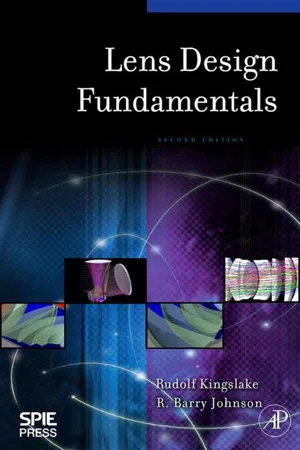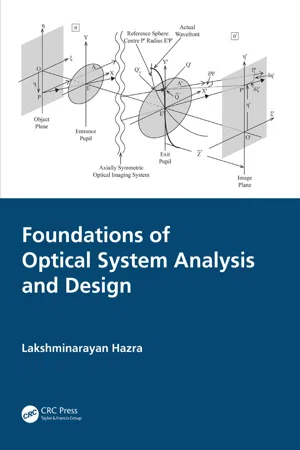Physics
Principal Point
The principal point in physics refers to the point on an optical system where the principal rays converge or appear to diverge from. It is a key concept in understanding the behavior of light rays as they pass through lenses and mirrors. The principal point is crucial for determining the formation of images in optical systems.
Written by Perlego with AI-assistance
Related key terms
Related key terms
1 of 4
Related key terms
1 of 3
4 Key excerpts on "Principal Point"
- eBook - ePub
- Rudolf Kingslake, R. Barry Johnson(Authors)
- 2009(Publication Date)
- Academic Press(Publisher)
a lens of any degree of complexity can be replaced by its cardinal points, namely, two Principal Points and two focal points , where the distances from the Principal Points to their respective focal points are the focal lengths of the lens. Gauss realized that imagery of a rotationally symmetric lens system could be expressed by a series expansion where the first order provided the ideal or stigmatic image behavior and the third and higher orders were the aberrations. He left the computation of the aberrations to others.To understand the nature of these cardinal-point terms, we imagine a family of parallel rays entering the lens from the left in a direction parallel to the axis (Figure 3.8 ). A marginal ray such as A will, after passing through the lens, cross the axis in the image space at J , and so on down to the paraxial ray C , which crosses the axis finally at F 2 .Figure 3.8 The equivalent refracting locus.If the entering and emerging portions of all of these rays are extended until they intersect, we can construct an “equivalent refracting locus” as a surface of revolution about the lens axis, to contain all the equivalent refracting points for the entire parallel beam. The paraxial portion of this locus is a plane perpendicular to the axis and known as the principal plane , and the axial point itself is called the Principal Point , P 2 . The paraxial image point F 2 , which is conjugate to an axial object point located at infinity, is called the focal point , and the longitudinal distance from P 2 to F 2 is the posterior focal length of the lens, marked f ′.A beam of parallel light entering parallel to the axis from the right will similarly yield another equivalent refracting locus with its own Principal Point P 1 and its own focal point F 1 , the separation from P 1 to F 1 being known as the anterior focal length f . The distance from the rear lens vertex to the F 2 point is the back focal distance/length or more commonly the back focus of the lens, and of course the distance from the front lens vertex to the F 1 point is the front focus of the lens. For historical reasons the focal length of a compound lens has often been called the equivalent focal length , or EFL, but the term equivalent is redundant and will not be used here.4 - Lakshminarayan Hazra(Author)
- 2022(Publication Date)
- CRC Press(Publisher)
8 ].It may be noted that the axial locations of the first and second principal foci can be ascertained from the above data if the refractive indices of the object and image spaces are known.It is sometimes useful to define a pair of conjugate axial points such that any ray incident on one of them emerges parallel to itself from the other point. This implies that in the paraxial invariance relationnu η =(3.120)n ′u ′η ′, and so transverse magnification between these two conjugates isu =u ′M =(3.121)(=)η ′η(n)n ′These two axial conjugate points are called nodal points, and are denoted by N and N′ (Figure 3.15 ). Using (3.113) and (3.114), axial locations of N and N′, with regard to the Principal Points H and H′ in the object space and image space, respectively, are given byHN =(3.122)l ˜=(F)n ′− n(3.123)H ′N ′==l ˜′(F)n ′− nWhen, the values ofn ′= nandl ˜are zero, and the nodal points coincide with the principal or unit points.l ˜′In Gaussian optics, the six points—namely the first and the second principal foci F and F′, the first and the second principal or unit points H and H’, and the first and the second nodal points N and N′—are called the cardinal points of an axisymmetric imaging system. For paraxial analysis, it is sufficient to know the location of the four cardinal points, which include the two foci, and either the two Principal Points or the two nodal points. The conjugate planes at the nodal points are often called the nodal planes. However, it should be noted that, except for the axial points, the equality of the convergence angles of an incident and the corresponding emergent ray does not hold good for paraxial rays passing through other points of the nodal planes. A well-known practical application of the concept of nodal points is the method of measurement of equivalent focal length of a lens system by nodal slide method.- eBook - ePub
Lens Design
A Practical Guide
- Haiyin Sun(Author)
- 2016(Publication Date)
- CRC Press(Publisher)
L and is refracted to become parallel to the optical axis. By principle, we can trace other rays to find the image. But these three rays are the easiest rays to trace. Actually, tracing either two of the three rays are enough to find the image of this object point.These three rays meet at a certain point as shown in Figure 1.22 . This point is the image of the top of the object. The images of any other points on the object can be found by using the same raytracing technique and the image of the whole object can thereby be found. Since the rays from one point on the object really reach the same point to form an image, such an image is a real image. We can see from Figure 1.22 that the object is above the optical axis with its wider part upward, while the image is below the optical axis with its wider part downward. The image orientation is opposite to the object, and we call this image negative.The situation shown in Figure 1.22 is reciprocal. If the current image is the object, we will find the current object to be the image by tracing three or two rays from right to left through the lens. The object distance o is defined as the horizontal distance from the object to the principal plane defined by P L and the image distance i is the horizontal distance from the image to the principal plane defined by P R , as shown in Figure 1.22 .1.3.2.2 Raytracing for a Positive Lens with a Virtual Image
In Figure 1.22 , we have o > f . When o < f , the situation is different, as shown in Figure 1.23 . The two rays traced from the top of the object through the lens do not cross. However, the backward extensions of the two refracted rays cross each other. If we are at the right-hand side of the lens and look at the lens, we will see a virtual image of the object. Since the image has the same orientation as the object, the image is said to be positive. In the setup shown in Figure 1.23 - eBook - ePub
- Randy O. Wayne(Author)
- 2013(Publication Date)
- Academic Press(Publisher)
i behind the lens. The focal planes are the two planes perpendicular to the principal axis that include a focal point.When rays traveling parallel to the principal axis strike a diverging lens, they diverge from the back of the lens in such a way as they appear to have come from a virtual image at the image focal point. When divergent rays strike a diverging lens, the rays emerge parallel to the principal axis in such a way as they appear to have come from a virtual source placed at the object focal point. While light diverges from a real object and converges toward a real image, it converges to a virtual object and diverges from a virtual image. For a real object placed at a given distance in front of the object focal plane of a converging lens, the more positive the focal length, the greater the magnification of a real inverted image and the farther it appears behind the lens. For a real object at a given distance in front of a diverging lens, the more negative the focal length of the lens, the greater the magnification of a virtual erect image and the farther it appears in front of the lens.In order to determine where an image formed by a lens will appear, we can use the method of ray tracing and draw two or three characteristic rays. Remember:Table 2.5• A ray that strikes a converging lens parallel to the principal axis goes through the image focus (fi ).• A ray that strikes a diverging lens parallel to the principal axis appears to have come from the image focus (fi ).• A ray that strikes a converging lens after it passes through the object focus (fo ) emerges parallel to the principal axis.• A ray that strikes a diverging lens on its way to the object focus (fo ) emerges parallel to the principal axis.• A ray that passes through the vertex (V) of a converging or diverging lens passes through undeviated.
Index pages curate the most relevant extracts from our library of academic textbooks. They’ve been created using an in-house natural language model (NLM), each adding context and meaning to key research topics.
Explore more topic indexes
Explore more topic indexes
1 of 6
Explore more topic indexes
1 of 4



